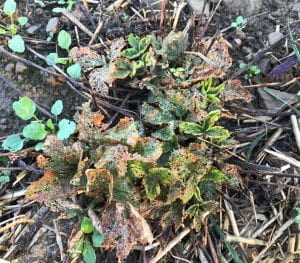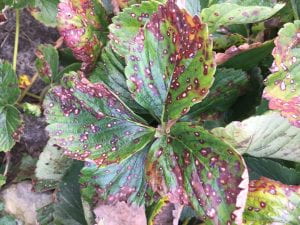from Laura McDermott, Eastern New York Commercial Horticulture Program
June bearing strawberries are “short day” plants that set flower buds in response to short days. As we get into late summer, days shorten and strawberry plants respond by setting the flower buds that will result in the crop next spring. It is important to maintain appropriate nutrition and soil water status during this time. General recommendations are to fertilize strawberry fields with 20 to 50 pounds of actual nitrogen per acre per during late summer. Nitrogen rates depend upon amount supplied at renovation and plant vigor. New fields with high vigor may not need additional nitrogen now, but older fields should benefit. Irrigation during this time is also extremely important if rainfall has not been sufficient in your area. We suggest about 1 inch per week. Continue to irrigate strawberries through fall to assure a good crop next year. Also maintain good leaf health by controlling leaf diseases.

Strawberry rootworm is an occasional but serious insect pest. It’s mostly a problem in new plantings, but can also cause real delay in grow back of renovated berries.
Leaf spot diseases can be a real problem for June Bearing plants. Keep an eye on the level of infection and try to control asap. Read more about this trio of diseases below.
Make sure to check day neutral berries for mites. The hot, dry weather promotes mite populations.
Annual Chandler fields should be planted by Labor Day. The later you wait, the less established they will be and the poorer they will winter and perform next spring. This goes for fall planted June Bearers like Jewel etc.
Day Neutral strawberries are finally beginning to fruit in dependable numbers. Keep removing runners so that all the energy goes to bud set in the crown. Once it gets to be September this is less of an issue because the 6 weeks after the middle of October is gravy for fruit anyway. Make sure they are getting plenty of fertilizer – between 3-5# of actual N per week – moving towards 5-7# N as the fruit starts to ripen – although this rate has been questioned by colleagues in NH and Pennsylvania. Depending on your soil type and the pre-plant nutrients added, we may be adding excessive amounts of Nitrogen when we should be focusing more on Potassium – more to come on this subject! Leaf analysis would help if you want to keep track of what is happening in the plant.
Improve Fruit Set and Overwintering by Controlling Leaf Spot Diseases
There are three primary leaf spotting diseases, and their impact on overwintering and fruit set has been severe in the last few years. Late summer is a good time to control leaf spot if your planting has over 10% of leaves with lesions. This is a lower threshold than the spring threshold of 25%, which draws attention to how detrimental the diseases can be to winter survival and fruit set. These two thresholds are found in a Canadian fact sheet that details timing of sprays – see Resource link below.
Leaf Spot (Mycosphaerella fragariae) lesions on leaves begin as small, irregularly shaped purple spots. Mature lesions become approximately one eighth to one quarter inch in diameter, remain relatively round, and the centers of lesions turn from a purplish brown to grayish white. The pathogen primarily infects young, expanding leaves and petioles, and occasionally fruit (this expression of the disease is called “black seed”).

Resistance and tolerance reports seem very unreliable. This year Jewel looks terrible, and in the Cornell Guidelines it is noted to possibly have some resistance to leaf spot. Cultural management techniques are very important. Improving air circulation in the field by reducing weed population will promote leaf surface drying and reduce infection periods. Destroying infected leaves during renovation will help limit inoculum.
Organic fungicides include, NuCop, Cueva, Badge X2, and copper sulfate. Conventional fungicides include Captan Gold, Rally, Pristine, Mettle, Cabrio, along with copper.
Leaf Scorch (Diplocarpon earliana) symptoms are spots about one eighth to one quarter inch in diameter and are scattered over the upper leaf surfaces or petioles. These spots differ from those of leaf spot in that they are purple throughout (no light centers). Numerous infections can cause a leaf to appear red or light purple and eventually to dry up and appear to have been burned (scorched). Heavy leaf infections can inhibit the production of flower buds for the following year, predispose a plant to winter injury, and provide inoculum for infection of the fruit caps. Although I’ve not sent samples to the lab, I think we have primarily leaf scorch in many plantings. Again, there are few agreed upon resistance ratings for cultivars. Cultural control techniques are the same as they are for leaf spot.
Organic products include Cueva, Badge X2, and conventional products include copper products and Topsin-M.
Leaf Blight (Phomopsis obscurans) lesions begin as small, circular to irregular, reddish, or purplish spots. As they expand, lesion centers become necrotic and turn light brown with a dark purple halo. Older lesions along major leaf veins develop into large V-shaped lesions that eventually kill the leaf. Again, heavy leaf infections can inhibit the production of flower buds for the following year, predispose a plant to winter injury, and provide inoculum for infection of the fruit caps.
There are no reports of cultivar resistance to leaf blight. Cultural control techniques are the same for leaf blight, scorch and spot. Early season fungicides are recommended when inoculum from the previous year is abundant or when conditions are favorable for the disease – this spring and summer!
Organic fungicide options include NuCop, Cueva or Oxidate. Conventional products include many formulations of copper (but check the label and make sure this disease is listed before apply it), Rendition, Agristar Sonoma, Mettle, and Topsin-M. Topsin-M should be mixed with copper to prevent fungicide resistance.
Resources:
2020 Cornell Pest Management Guidelines for Berry Crops.
STRAWBERRY LEAF SPOT Control strategies; Brodeur, C., O. Carisse, and G. Bourgeois; Agriculture and
Agri-Food Canada, Research Branch. http://publications.gc.ca/collections/Collection/A42-87-1997E.pdf
